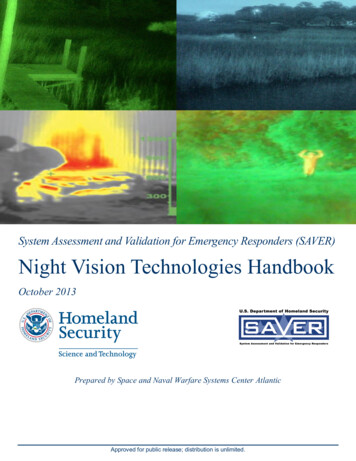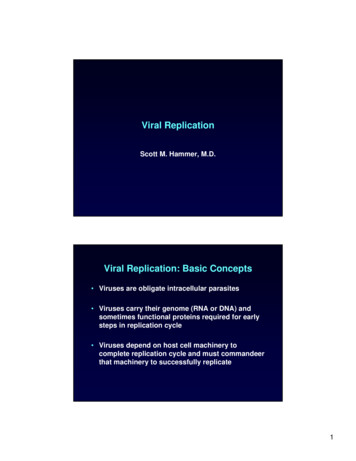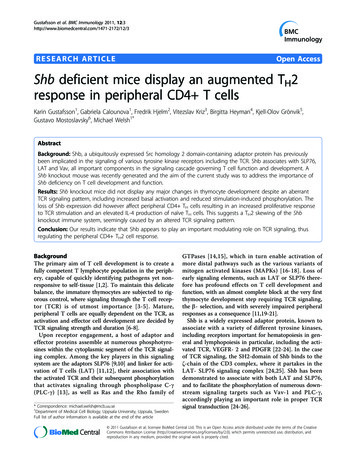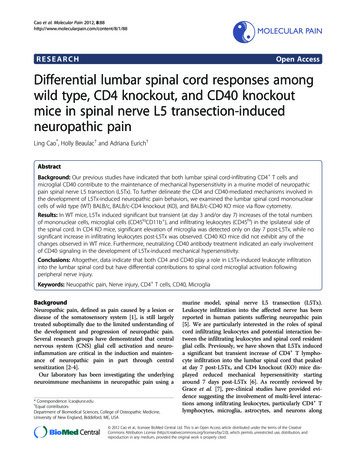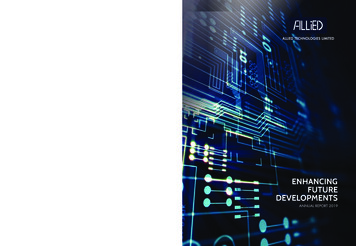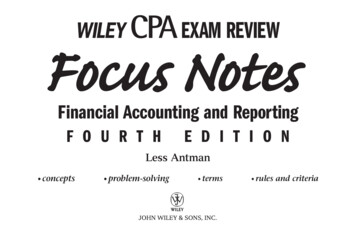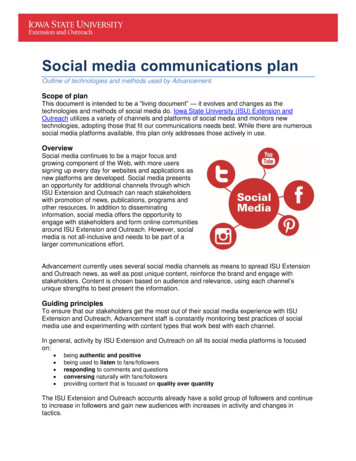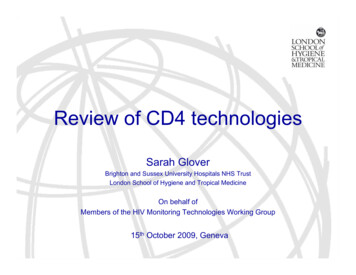
Transcription
Review of CD4 technologiesSarah GloverBrighton and Sussex University Hospitals NHS TrustLondon School of Hygiene and Tropical MedicineOn behalf ofMembers of the HIV Monitoring Technologies Working Group15th October 2009, Geneva
Considerations when choosing CD4technologyOperational characteristics Environmental requirements of the technology: instrumentation, power supply, refrigerationof reagents, robustness to heat and humidity Parameters measured Ease of use, training required, degree of automation Cost Throughput Compatibility with EQA programmes and availability of QC reagents Compatibility with stabilised specimens Optimum operational characteristics may be different for different levels of healthcaresystemPerformance Accuracy: how similar are the results obtained with the new technology to results of areference technology? Includes bias and misclassification. May vary with magnitude ofresult, most important to know the accuracy over the clinically important range and aroundtreatment cut‐offs Precision: How close are the results of replicate specimens using the same new technology
Available CD4 technology Flow cytometry– Works on the principle of light scatter (due to differentsize or granularity of the cell) combined with fluorescenceof cells after staining with monoclonal antibodies to cellsurface markers tagged to fluorescent dyes– Population of interest can be identified and gated– Percentage of CD4 T cells can be calculated (% oflymphocytes, or % of leucocytes)– Absolute CD4 count can then be determined using eitherdual‐ or single‐platform methodology
Dual platform:– Uses a haematology analyser‐generated wbccount and differential– Combining this with the CD4% gives absolute CD4count Single platform:– Derive absolute counts directly from flowcytometer without need for haematology analyser– Either by counting CD4 T cells in a preciselydetermined blood volume or by using a knownnumber of fluorescent beads mixed with a knownvolume of blood
Single platform may be achieved by modifieduse of a ‘traditional’ flow cytometer, by theaddition of beads (eg TruCount, FlowCount orPerfect Count beads) Alternatively, several dedicated singleplatform cytometers have been developed egFACSCount (bead‐based), Guava, CyFlow(both volumetric)
Manual methods Microscope based– Cytospheres: latex spheres coated withmonoclonal antibody form rosettes on contractwith CD4 cells which are visible by lightmicroscopy– Dynabeads: magnetic particles coated withmonoclonal antibody allow isolation of CD4 cells,which are lysed and stained nuclei counted usingfluorescent microscope
Available CD4 technologyTechnology for which independent, peer‐reviewed performance evaluation data is available:Flow cytometry Dual platformSingle platform bead‐based technology on standard flow cytometer:TruCount beadsFlowCount beadsPerfect CountSingle platform dedicated CD4 flow systems:FACSCountGuava Easy CD4Partec CyFlow Counter, Partec CyFlow SL 3Manual technologies CytospheresDynabeadsTechnology in use but for which no peer‐reviewed independent performance evaluation data isavailable: PointCare NOWGuava Auto CD4CD4 selectSysmex pocH‐100i
Operational characteristics ofavailable CD4 technologies
FLOW CYTOMETRYAssay nameManufacturerInstrumentationAssay principleParameters measuredSpecimenThroughputCompatible withindependent EQA/PTprogrammes?Is there access tocompatible QC reagent?Maximum length of time fromblood draw to testingDoes the test perform onfixed/ stabilised bloodComplexity/training requiredEnvironmental/energy issuesRobustness to heat/humidityDual platformVariousNot applicableFlow cytometer plus haematologyanalyserAbsolute count calculated usingresults from flow cytometrytogether with the total wbc countor lymphocyte count fromhaematology analyserAbsolute CD4 and CD4%Others depend on reagentkits/methodsWhole blood in EDTAUp to 250/dayYesYesBead‐based single platform technology on conventional flow cytometerTruCount beadsFlowCount beadsPerfect CountBecton DickinsonBeckman CoulterCytognosCompatible with various reagent systems and flow cytometersFlow cytometerAbsolute CD4 counts determined using ratio of CD4 to a known quantity offluorescent beads – no need for haematology analyserTruCount tubes containLiquid beads need accurate Two different beadpremeasured quantity ofpipetting by operatorpopulations allowlyophilised beadsdetection of inadequatemixingAbsolute CD4 and CD4%YesWhole blood in EDTAUp to 250/dayYesYesYesYesYes24 hoursYesComplex. Significant trainingrequired.Requires uninterrupted mainselectricityClimate control recommended5 days for PLG, otherwise 24 hoursYesYesYesComplex. Significant training requiredRequires uninterrupted mains electricityClimate control recommended
DEDICATED SINGLE PLATFORM CD4 SYSTEMSAssay nameFACSCountManufacturerBecton DickinsonInstrumentationFlow cytometerAssay principleDedicated single platform bead‐basedflow cytometer, two colour, no‐lyse no‐washGuava Easy CD4Guava TechnologiesFlow cytometerSingle platform, two colour, volumetricflow cytometer. Microcapillary flow cell.Partec CyFlow Counter or CyFLow SL 3PartecFlow cytometerVolumetric SP flow cytometer. Up to 3parameters (2 colour plus SSC). Simplest issingle parameter CD4 (CD4 easy countkit). For CD4%, 2 colour (CD45/4) SSC.Absolute CD4, CD8 and CD3 counts, CD4/8ratioNewer reagents give absolute CD4 countand CD4%50µl whole blood in EDTA 15 pairs per hour, at CD4 counts 200Absolute CD4, CD8,CD3Easy CD4% assay measures CD4%Absolute CD4, CD4%10µl whole blood in EDTA100‐150 specimens per day20µl whole blood in EDTA250 tests/day, 400/day with automatCompatible with independentEQA/PT programmes?Is there access to compatible QCreagent?YesYesYesNo manufacturer‐produced full processcontrolNo manufacturer‐produced full processcontrolNo manufacturer‐produced full processcontrolMaximum length of time fromblood draw to testingStain within 48 hours of draw (24 hoursfor CD4%) (store at 20‐25 C), analysewithin 48 hours of staining.Yes48 hours48 hoursYesYesComplexity/training requiredEnvironmental/energy issuesOne day trainingRequires uninterrupted mains electricityComplex, significant trainingMains electricity or car battery or solarpanelsRobustness to heat/humidity10‐35 C, 5‐95% non‐condensing humidity.Reagents require refrigeration.One day trainingLess biohazardous waste (reduced by 100fold)Requires mains electricityInstrument: up to 35C. 10‐90% non‐condensing relative humidity. Reagentsneed refrigeration.Parameters measuredSpecimenThroughputDoes the test perform on fixed/stabilised bloodSolid state laser more stable than water orair cooled gas lasers at high temperatures.Reagents need refrigeration, although dryreagent kits available which can be storedat up to 60 C in dark for up to 12 months
MANUAL METHODSAssay nameCoulter Manual CD4 Count Kit (Cytospheres)Dynal T4 Quant Kit (Dynabeads)ManufacturerBeckman CoulterInvitrogen/Dynal biotechInstrumentationLight microscope, haemocytometerFluorescent or light microscope, haemocytometer, magnetAssay principleInert latex spheres coated with monoclonal Ab formrosettes on contact with CD4 cells ‐ readily visible bylight microscopyMagnetic polystyrene beads, coated with mousemonoclonal Ab, allow isolation of CD4 T cells followed bycounting using fluorescent (preferable) or light microscopeParameters measuredAbsolute CD4 countAbsolute CD4 countSpecimen100µl whole blood in EDTA125µl whole blood in EDTA or ACDThroughput10 per day. Operator fatigue limiting. Suggest stopcounting at 500 cells. Batch size limited to 2 samplesNo10 per day. Operator fatigue limiting. Suggest stop countingat 500 cells. Batch size limited to 6 samplesNoIs there access to compatible QCreagent?NoNoMaximum length of time fromblood draw to testing72 hours at 20 C72 hours at 20 CDoes the test perform on fixed/stabilised bloodNoCompatible with Cyto‐Chex stabilised refrigerated samplesup to 9 days after collection. Not compatible with TransFix.Complexity/training required1‐3 days training1‐3 days trainingEnvironmental/energy issuesPower for microscopePower for microscopeRobustness to heat/humidityReagents need refrigerationReagents need refrigerationCompatible with independentEQA/PT programmes?
Technologies in use but for which no peer‐reviewed independent evaluation data is availableAssay namePointCare NOWGuava Auto CD4ManufacturerPointCare technologiesGuava technologiesInstrumentationPOC instrumentFlow cytometerPOCH‐100SysmexHaematology analyserCD4 Selecti MED Laboratories Co. Ltd.Haematology analyser,magnet, rotator, computerFerrous beads coated withMT4 mAb bind to CD4 T cells,which are then removed usingmagnet. CD4‐deplete bloodcounted on haematologyanalyser. Software generatescount and %Assay principleCD4 and haematologyAuto CD4 reagents replacingcontained in one unit.Easy CD4. Run on sameGold nanoparticlescytometer (Guava PCA)conjugated to CD4 antibodies(no fluorescence). LED lightsource.CD4 cell isolation usingDynabeads, countingusing haematologyanalyserParameters measuredAbsolute CD4, CD4%, Hb,differential white cell countAbsolute CD4 count andCD4%Absolute CD4 and CD4%Specimen40µl whole blood in EDTA10µl whole blood in EDTAAbsolute CD4 count,CD4%, CBC, 3 part WCCdifferentialWhole blood in EDTAThroughputCompatible with independentEQA/PT programmes?Is there access to compatible QCreagent?Maximum length of time fromblood draw to testingDoes the test perform on fixed/stabilised blood50/dayNo100/dayYesNo data availableNo data available12 per hourNo EQA evaluation dataavailableNo data available?No EQA evaluation dataavailableNo data available8 hours48 hours24 hours at 4 or 20 CNo data availableNo data availableNo data availableComplexity/training requiredFully automated. Intendedfor POC useMains or battery powerManufacturer report reliable No data availableresults with Transfix up to 11daysTwo days trainingModerate complexityEnvironmental/energy issuesRobustness to heat/humidityMains electricity required,Power for haematologyUPS optionanalyserReagents do not needInstrument: up to 35C. 10‐No data availablerefrigeration. Instrument: 18‐ 90% non‐condensing relative34C, 80% relative humidity, humidity. Reagents neednon‐condensingrefrigeration.400µl whole blood in EDTAPower for haem analyser,rotator and computerNo data available
PerformanceAccuracy No gold standard technology or internationally recognised reference preparationexists for CD4. This makes it hard to obtain the ‘truthful’ result against which tocompare a new methodology Correlation alone is insufficient Bland‐Altman plot alone (with or without “limits of agreement”) is insufficient Misclassification probabilities provide more clinically useful information about thetest under evaluation Two types of misclassification can be defined — upward misclassificationprobability and downward misclassification probability. Upward misclassification around a treatment threshold may be most clinicallyimportant (leading to delay of start of ART or prophylactic treatment in somepatients). Downward misclassification may result in the decision to treat large numbers ofadditional patients who have CD4 counts above the guideline threshold whenusing the reference test.
Performance cont.Precision Reproducibility of the new test when repeated on the same specimen.Includes within‐run, between‐run, between‐operator, between‐laboratory Usually measured as coefficient of variation (CV) Badly underestimated if based on too few replicates In evaluating a particular technology, we need to know about both itsaccuracy and its precision
Literature review of performanceof CD4 technologies
Systematic review underway What is already clear is that clinically relevantquestions are difficult to answer from literature Studies often conclude that a method is anacceptable alternative to a reference method basedon correlation alone, or based on a ‘mean difference’between the two, which gives no indication ofmaximum differences seen (which may be large,despite a small mean difference), and which is oftendifferent at different levels of CD4, even within theclinically important range
From Karcher et al 2006 CytometryPart B 70B:163‐169On correlation analysis, r 0.929However, 29% of specimens with CD4 350 using FACScanmisclassified as 350 when using CyFlow
Mean difference minimal (4 cells/µl).But maximum differences large (-500 to 400)From Spacek et al. J AcquirImmune Defic Syndr Vol41, 5, 2006
Does a particular method have ‘acceptably low’misclassification probabilities? i.e. can I beconfident that 350 is really 350 31 studies, 15 gave data from which can calculatemisclassification either side of 200, and only 5provided data which allowed calculation ofmisclassification either side of 350
CytospheresDynabeadsGuavaCyFlowMisclassification up (upper figure) and down (lower figure), using athreshold of 200 cells/µl
CytospheresDynabeadsGuavaCyFlow
Both misclassification up and down are likely to beunderestimates (particularly down) as none of the studies arerestricted to the most clinically relevant range We cannot tell from the published papers the magnitude ofthe misclassification: are they mostly barely away from thethreshold (e.g. 10 CD4 cells) or are they mostly far away (e.g.100 CD4 cells)? A more pertinent question might be how many samples in the150 ‐ 250 range are being misclassified as having CD4 350,or how many samples in the 450‐550 range are beingmisclassified as 350 But this is impossible to answer from the published literature(although authors likely to have primary data from whichthese could be calculated)
Precision Reproducibility on repeat testing of samesample by same method Important if following a patient's serialmeasurements Probability of misclassification is worse ifprecision is worse, although bias of 10% hasmore of an effect on misclassification than CV(measure of precision) of 10%
MethodStudyCytospheres 1DynabeadsCD4 if given No. ofreplicatesper donorWithin‐lab whole‐processreproducibility on wholeblood (CV%)Index testFlowcytometry200?10112.52Not given?25863Not given28843501082
Given the limitations of available data,what can we say with any degree ofconfidence? There is variability associated with CD4 measurement, bothphysiological and technology‐related, whichever technology is used Different technologies are associated with different performancecharacteristics, both in terms of misclassification and precision These characteristics, particularly misclassification, should beconsidered before choosing to implement a technology, but thedata are not always available Given the potential for error, participation in EQA programmesand access to QC reagents is essential
Hierarchy of technologies based on performance levels:Single platform flow cytometry dual platform‐‐doesn't rely on hematology analyzer, so less variability, especiallywith older blood specimensDual platform Manual methods‐‐lower misclassification probabilities, better precision,availability of EQA materials and programmesDifficult to place Guava and Cyflow in hierarchy‐‐limited data on misclassification. Widely varying results with CyFlowin different papers, and wide variety of instruments and reagentsmake papers difficult to compare
Essential operationalcharacteristics for CD4 and viralload technologies at differentlevels of the health care system
Desirable characteristics for viral load technologies in the clinical management of patients withHIVAt tertiary/reference lab levelAt district levelAt primary levelMeasure RNA HIV 1 (2 if relevant tolocation), RTReliably 1000 or less copies/ml orRT equivalenceMeasure RT or send plasma or DBS Collect DBSaway for RNA testingReliably 1000 or less copies/ml orRT equivalenceMethodPCR or RT-ELISART-ELISASend DBS or POC whenavailableSpecimen typeWhole blood (EDTA not heparin),plasma or dried blood spotUp to 1.2ml plasma depending onmethodPreferably 0.5mlWithin 2 weeks*Maybe requiredWhole blood (EDTA not heparin),plasma or dried blood spot1mlWhole blood finger or heelprick50-75 ulUp to 1mlWithin 2 weeks*No50-75 ulWithin 3-6 weeksNoMedium or high (at least 30 per twoweeks)May be highDedicated training essentialMedium or high (at least 30 per twoweeks)MediumDedicated training essentialVariableRequires uninterrupted mainselectricity, may require climatecontrolRequires freezer and fridgeNoneStorage requirements of reagentsRequires uninterrupted mainselectricity, may require climatecontrolRequires freezer and fridgeStorage requirements of specimensRequires freezer and fridgeRequires freezer and fridgeRequires dessicantMaintenance/machine calibrationEssentialYesNoService after the saleAdditional equipment/facilities requiredEssentialRequires sufficient space for PCRsuiteMust be available but notnecessarily from manufacturerEssential for all platformsYesELISA reader, incubatorNoNoMust be available but notnecessarily from manufacturerEssential for all platformsNoInvestigationsPerformance criteriaSpecimen volume: adultSpecimen volume: paediatricTime to resultFurther analysis of data required? EgmultiplicationThroughputComplexityTraining requiredEnvironemental/energy issuesAvailability of QC reagentsParticipation in manufacturer-independent QAprogrammeHow does the test perform on aged specimensand what is upper limit of storage time beforetestingLowTraining essentialNoneRegular auditingSpecimens should be processedSpecimens should be processedThoroughly dried then storedwithin 24 hours then plasma may be within 24 hours then plasma may be with desiccant prior tofrozenfrozenshipping* except in PMTCT services where more urgent results might be required
InstrumentationParameters measuredPerformance criteriaMethodDesirable characteristics for CD4 technologies in the clinical management of patients with HIVAt tertiary/reference laboratory levelAt district levelAt primary levelFlow cytometryFlow cytometry or microscopePOC - variableBoth absolute count and CD4%Both absolute count and CD4%Absolute CD4 as a minimum (qualitative orquantitative)?Single (preferable) or dual platform flow cytometerPOC when availableAutomationYesSingle (preferable) or dual platform flowcytometer or manual methodNot essentialSpecimen typeSpecimen volume: adultWhole bloodVolume should equal at least the minimum volumeof EDTA blood collection tubeWhole bloodWhole bloodVolume should equal at least the minimum Finger prickvolume of EDTA blood collection tubeSpecimen volume: paediatricVolume should equal at least the minimum volumeof EDTA blood collection tubeVolume should equal at least the minimum Finger prick/heel prickvolume of EDTA blood collection tubeTime to resultFurther analysis of datarequired? Eg multiplicationThroughputSame dayOptionalSame dayOptionalLess than 1 hourNoneHigh: 50 per dayMedium: 10-50 per dayLow-medium: 1-20 per dayComplexityEase of use/training requiredHighMay be sophisticated, with supervision required andsignificant training. May require dedicatedlaboratory and technical expertiseRequires uninterupted mains electricity, climatecontrol recommendedMay require fridge and freezerMediumModerate, with minimal supervisionrequired after training. Does requirelaboratory and technical expertiseRuns on battery, climate controlrecommendedMay require fridgeLowSimple, with no supervision required afterminimal training ( 4 hours). Does not requirelaboratory or technical expertiseRuns on battery or solar power or no need forelectricityNo cold chain requirementsAmbient temperature 10-35CAmbient temperature 10-30CSamples should be run immediatelyEssential 6 ental/energy issuesStorage requirements ofreagentsStorage requirements ofspecimensMachine maintenanceNoMachine calibrationService after the saleEquipment/facilities requiredDailyEssentialStandard laboratory equipment including computerAvailability of QC reagents
Flow cytometry Dual platform Single platform bead‐based technology on standard flow cytometer: TruCount beads FlowCount beads Perfect Count Single platform dedicated CD4 flow systems: FACSCount Guava Easy CD4 Partec CyFlow Counter, Partec
